Name USS Ross Ordered 8 April 1992 Commissioned 28 June 1997 Construction started 10 April 1995 Length 154 m | Laid down 10 April 1995 Homeport Rota, Spain Launched 22 March 1996 Draft 9.45 m | |
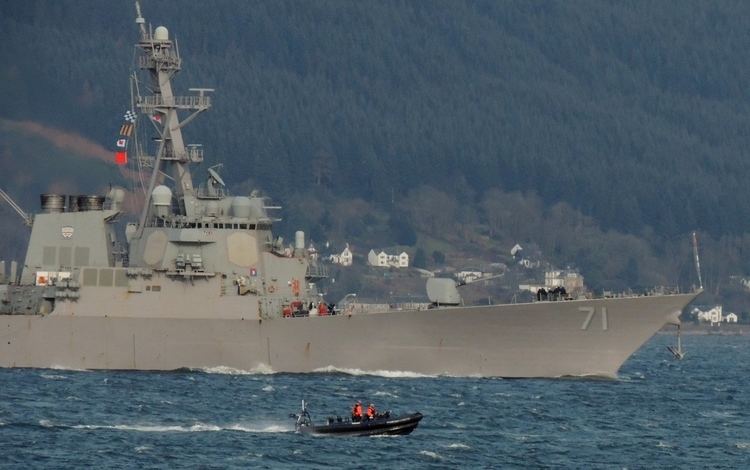 | ||
Uss ross ddg 71 and uss whidbey island lsd 41
USS Ross (DDG-71) is an Arleigh Burke-class guided-missile destroyer in the United States Navy. She is named for Medal of Honor recipient Donald K. Ross, the second Navy ship of the name. This ship is the 21st destroyer of its class. USS Ross was the 10th ship of this class to be built at Ingalls Shipbuilding in Pascagoula, Mississippi, and construction began on 10 April, 1995. She was launched on 22 March 1996 and was christened on 10 April 1996. On 28 June 1997, she was commissioned from Galveston, Texas.
Contents
- Uss ross ddg 71 and uss whidbey island lsd 41
- History
- Upgrade
- Commanding officers
- Shield
- Crest
- Motto
- Seal
- References
History
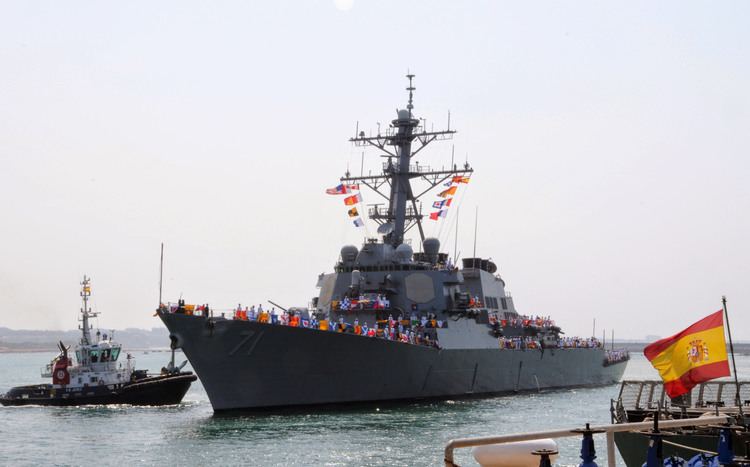
After commissioning, Ross set sail for a Combat Systems Ship Qualification Trial, which lasted six weeks, and then sailed back to Pascagoula for three months for her Post Shakedown Availability (PSA). She was then returned to her homeport of Portsmouth, Virginia and completed the Basic Training Phase: Engineering Certification, CART II, TSTA I, and III, Cruise Missile Tactical Qualification, Final Evaluation Period (FEP), and Logistics Management Assessment.
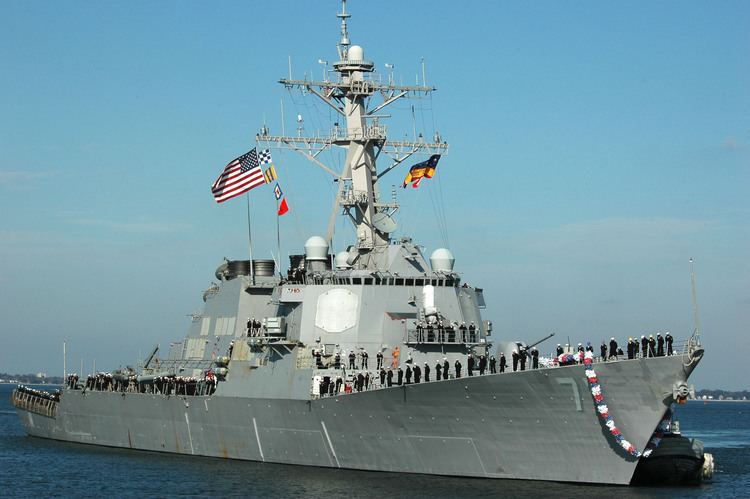
Ross completed her Intermediate Training Phase and set sail early in 1999 as part of Carrier Group 8, led by USS Theodore Roosevelt. The group sortied for a Joint Task Force Exercise to prepare for an upcoming six-month deployment set to commence on 26 March 1999. During this deployment to the Mediterranean Sea and Adriatic Sea Ross participated in Operation Allied Force. On 22 September she returned to Naval Station Norfolk.
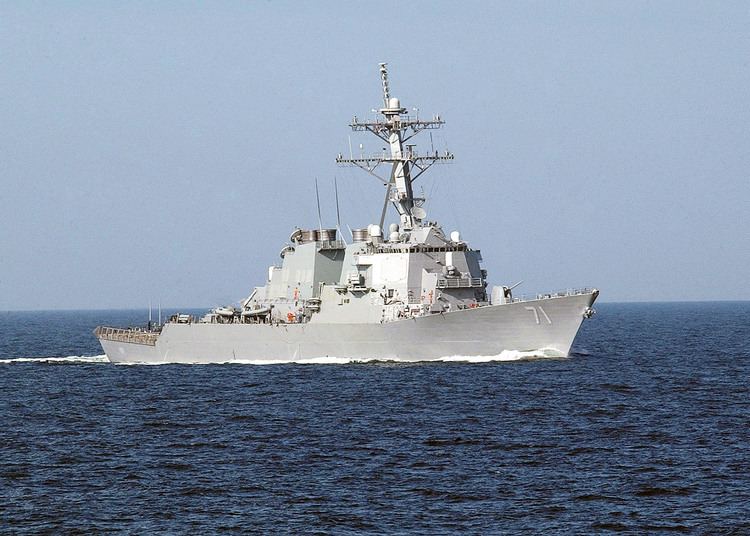
On 15 May 2000 she set sail for Northern Europe in order to participate in the Baltic Operations (BALTOPS) 2000. She served as the flagship for the Commander of Carrier Group Eight, and together with the destroyer USS Peterson operated with more than 50 ships from the numerous European countries. During these exercises Ross visited Stockholm, Sweden and Kiel, Germany before returning to the United States in late June.

On 16 October 2001, Ross was deployed to the Mediterranean Sea and Persian Gulf in support of Operation Enduring Freedom, and conducting operations in support of the U.N. resolutions against Iraq. During this deployment, Ross was again part of the USS Theodore Roosevelt Battle Group.
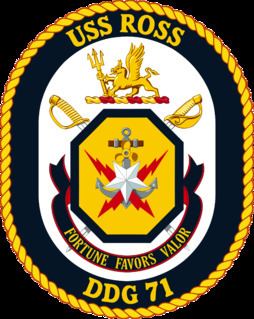
On 6 June 2005, a .50 caliber machine gun on her deck fired while leaving a shipyard. The single .50 caliber bullet struck a nearby barge and two washing machines within the barge. The gun was discharged while performing a check on its firing operation.
Later in 2005, Ross participated in UNITAS 47-06 in place of the cruiser USS Thomas S. Gates due to the damage to Pascagoula created by Hurricane Katrina. Ross enjoyed liberty in Curaçao, St. Maarten, and Rio de Janeiro while participating in the multi-ship exercise with naval forces from Argentina, Brazil, Chile, Spain, and Uruguay. During the return home, Ross encountered heavy seas at high speeds resulting in a tear in her hull. The crew isolated her flooding and performed de-watering during the remainder of the journey up the Atlantic coast eventually arriving in Norfolk in time for Thanksgiving.
In 2006, Ross returned from a six month deployment to the Mediterranean Sea as part of Standing NATO Maritime Group 1. She conducted over 850 vessel queries, commanded over 17 different ships from various nations, performed over 40 helicopter landings and takeoffs and 41 port visits to six different countries and 14 different ports. From 1 May 2006 to 7 November 2006, Ross traveled over 64,000 nautical miles (119,000 km; 74,000 mi). In Alicante, Spain in August 2006, Ross became the group flagship, embarking the American commander of the standing maritime group. Her mission was to perform as part of Operation Active Endeavour; deterring terrorism, smuggling and human trafficking in the Mediterranean.
In September 2014, responding to turmoil in Ukraine, the U.S. Navy announced that a guided missile destroyer had entered the Black Sea in order to participate with Ukrainian ships in the naval exercise "Sea Breeze". USS Ross "serves to demonstrate the United States’ commitment to strengthening the collective security of NATO allies and partners in the region," the Navy said in a press release.
In November 2014, three sailors from USS Ross were attacked while ashore in the port of Istanbul, apparently by members of the Turkey Youth Union.
In May 2015, Ross was buzzed by a pair of Russian Su-24 Fencers at a distance of 500 meters while the ship was on-station in the Black Sea. Russian Federation State media RIA Novosti quoted a military source, which claimed that USS Ross had acted aggressively and was scared away by the bombers. The US Navy published a statement, denying the Russian claims and pointing out that the ship was in international waters and did not deviate from its operations.
On 21 October 2015, Ross intercepted a Terrier missile as part of ASD-15 anti-ballistic missile testing in the North Sea.
Upgrade
On 12 November 2009, the Missile Defense Agency announced that Ross would be upgraded during Fiscal Year 2012 to RIM-161 Standard Missile 3 (SM-3) capability in order to function as part of the Aegis Ballistic Missile Defense System.
Commanding officers
The Commanding Officer (CO) of USS Ross is the most senior officer that is in command of the ship. Sailors will refer to the CO as "the Captain" (regardless of rank), or sometimes informally as "Skipper". Below is the list of commanding officers of USS Ross.
Shield
The shield is in the shape of a hexagon with a gold background and blue trim. The center of the shield consists of an inverted silver star, anchor and crossing red lightning bolts.
The traditional Navy colors were chosen for the shield because dark blue and gold represents the sea and excellence respectively. The anchor represents the anchorage at Pearl Harbor, which brought the United Stated into World War II after being attacked December 7, 1941. The propeller represents Warrant Officer Ross and a Navy Machinist badge signifies the post he held at the time of action. The inverted silver star stands for his heroism during the attack and the Medal of Honor he won for valor on board the battleship USS Nevada. The shields shape refers to the AEGIS combat system of DDG-71. The color gold represents excellence, while red denotes courage and sacrifice.
Crest
The crest consists of a griffin holding a trident with a red and gold framing below.
The griffin, denotes vigilance, intelligence, and valor, reflects USS Ross’ versatile operational capabilities. The griffin holds a trident to represent the ships offensive equipment with exceptional firepower. The color gold represents excellence.
Motto
The motto is written on a scroll of blue that has a red reverse side.
The ships motto is "Fortune Favors Valor ". The motto is a reference to both the honorable feats of Admiral Ross and the Medal of Honor he received.
Seal
The coat of arms in full color as in the blazon, upon a white background enclosed within a dark blue oval border edged on the outside with a gold rope and bearing the inscription "USS ROSS" at the top and "DDG 71" in the base all gold.
